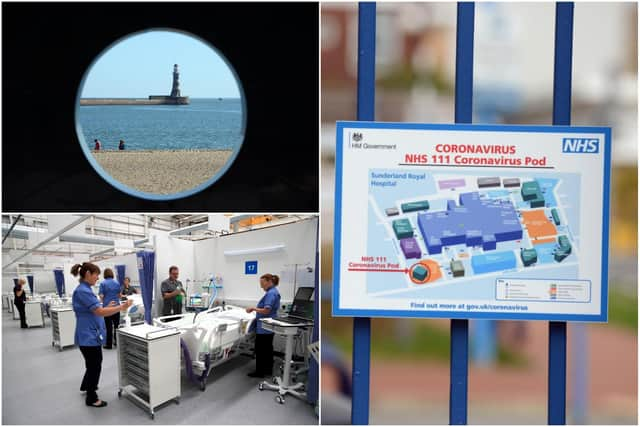Your questions answered on why Sunderland's coronavirus infection rate is so high
and live on Freeview channel 276
This week you’ve asked us about using facemasks, going back to school and why Sunderland has higher rates of Covid-19 infections than other areas.
We’ve put those questions to Gillian and she’s answered them below.Remember, if you have something you would like to ask or would like advice or guidance on any issues that impact on people’s health in Sunderland, please contact us on our Facebook page and we will send a selection to Gillianeach week.
Advertisement
Hide AdAdvertisement
Hide AdIn this first piece, Gillian talks about rates of infection.


Over the coming days, we'll have Gillian's answers on using facemasks and going back to school.
Ivor Prestwood asked: “What does she put the high rates of COVID-19 infections and deaths down to in Sunderland?”
Diana Lambton said: “Newcastle has a higher population, more older people and the same if not more people with underlying health issues, poverty and deprivation.
Advertisement
Hide AdAdvertisement
Hide Ad“But their death rates are significantly lower than Sunderland.


“What are they doing right in Newcastle that Sunderland isn't?
“Does the public health team in Sunderland have any local research to know what Sunderland’s current asymptomatic and symptomatic infection rates are – the background rate of infection?”
Lucy Froggat' asked: “Sunderland has the highest number of COVID-19 cases outside of London.
Advertisement
Hide AdAdvertisement
Hide Ad“What can you do to help convince the people of Sunderland to stick with the social distancing rules and the wider lockdown?
“Why do you believe we have more cases than other cities?”
Gillian said: “The information that we have relates to the number of people who have been tested and have had a positive result rather than the level of infection.
“As many readers will know, Sunderland has one of the highest levels of positive tests when related to the population.
“One reason for this is that in the early days of the pandemic we think that more Sunderland residents were admitted to hospital than was the case nationally.
Advertisement
Hide AdAdvertisement
Hide Ad“At this time, the Government’s testing strategy was to only test people with symptoms who were admitted to hospital and so places that had more hospital admissions will also have higher levels of testing and therefore more positive results.
“Sadly, we have seen more deaths in Sunderland than in many other places.
“This, alongside the higher number of positive cases reported, seems to suggest that there is a higher level of infection in the city.
“We do know, however, that we have a higher proportion of people in Sunderland that are more likely to develop a more severe illness when they are infected than elsewhere in the country for a range of reasons
Advertisement
Hide AdAdvertisement
Hide Ad“We know from research across the world that older people are most likely to suffer serious illness when they catch COVID-19 and, although the majority will still recover, they are more likely to die than the rest of the population.
Ageing population
“In Sunderland we have a higher proportion of older people than the rest of the country and 14% of our population is aged over 70 while Newcastle, for example, only has 10% of its population in this age group.
“Research has also told us that those with chronic diseases and those who have less healthy behaviours, particularly those who smoke and those who are obese, are more likely to develop a serious illness if they become infected.
“Again, for many reasons, we have more people in Sunderland who would fall into these groups.
Advertisement
Hide AdAdvertisement
Hide Ad“Although people with long term conditions and unhealthy behaviours are more likely to have severe illness, for communicable diseases such as COVID-19, people will only become infected if they come into contact with the virus.
“That is probably why we are seeing higher rates of deaths in urban as opposed to rural areas.
“The highest rates of death are seen in urban areas that are part of large urban conurbations such as Tyne and Wear while the lowest are in rural hamlets and isolated dwellings.
“Even when population size is taken into account, large urban conurbations have seven times the death rate of the most rural areas.
City’s legacy of deprivation
Advertisement
Hide AdAdvertisement
Hide Ad“Finally, the Office for National Statistics published a report in recent weeks that highlighted the strong impact of deprivation on COVID-19 deaths.
“This showed that deaths in the most deprived areas in the country were double those in the least deprived.
“There is, therefore, no easy answer as to why we are seeing high levels of deaths in Sunderland.
“There are many factors that we know will be involved but there are likely to be more that we do not yet know about.
Advertisement
Hide AdAdvertisement
Hide Ad“COVID-19 is still a very new disease and so there is still relatively little that we know about it.
“We continue to look at data and research that becomes available to try and understand what is happening.
“We do know, however, that the best way to reduce infection is to practice social distancing and to keep washing our hands.
“We can also reduce our risk of developing a serious illness by keeping ourselves as healthy as we can.”